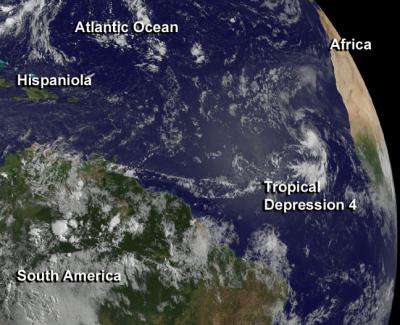NASA sees newborn eastern Atlantic tropical depression

The fourth tropical depression of the Atlantic Ocean hurricane season was born west of the Cape Verde Islands in the Eastern Atlantic Ocean on July 24. NOAA's GOES-13 satellite provides continuous views of the Atlantic Ocean basin and captured an image of the newborn storm.
At 5 a.m. EDT on July 24, the National Hurricane Center announced the birth of Tropical Depression 4 or TD4. At that time TD4 had maximum sustained winds near 35 mph (55 kph). It was centered about 310 miles (500 km) west-southwest of the Cape Verde Islands, near 13.9 north and 28.1 west. TD4 was moving to the west-northwest at 20 mph (32 kph) and had a minimum central pressure of 1008 millibars.
NOAA's eastern Geostationary Operational Environmental Satellite known as GOES-13 captured a visible image of Tropical Depression 4 in the far eastern Atlantic Ocean on July 24 at 11:45 UTC (7:45 a.m. EDT). The image was created by the NASA GOES Project located at NASA's Goddard Space Flight Center in Greenbelt, Md.
The image showed that the storm had become more organized overnight, and strong convection (rising air that forms thunderstorms that make up the tropical depression) had increased in coverage and become more concentrated around the center.
The National Hurricane Center noted that TD4 may strengthen slightly and reach tropical storm status later in the day or on July 25 before running into drier air and cooler waters. Dry air absorbs the moisture needed to form thunderstorms, and tropical cyclones need water temperatures of at least 80F/26.6C to maintain strength.
If TD4 strengthens into a tropical storm it would be renamed Dorian.
Provided by NASA's Goddard Space Flight Center





















